
At the 2023 Holley Moparty at Beech Bend Raceway Park in Bowling Green, Kentucky, a black, modest appearing 1970 Duster was mixing it up with twenty heavy hitters in the Grand Champion Competition vintage class. The Duster, owned by Tim Talbot of South Louisiana, finished 4th in the class on a suspension that he had completed less than a week before the Moparty event.

Above: Tim Talbot has owned his Pro-Touring Duster since the 1990s. It has proven to be a great autocross vehicle, a decent quarter-mile ride, and an excellent street cruiser. Hence, a triple threat Mopar. (Photo – Owner’s Collection)
Talbot has owned the Duster since 1997, and he and the Duster have changed significantly over the last 25 years. The Duster started as a bare shell, and Talbot, still a teenager, brought it back to life with a stock-style restoration. With only the help of a friend, Talbot rebuilt a 340 and 727 transmission to nearly stock specs. He painted the car Lemon Twist yellow and added 1971 side stripes with a blacked-out hood and 340 wedge callout graphics.
After piecing together the rest of the driveline and an interior, Talbot hit several local car shows and cruise nights. However, as is often the case with those in their late teens and early twenties owning a muscle car, the drag racing bug bit. The Duster experienced many changes and upgrades, all to reduce its quarter-mile elapsed times.
Above: The Duster’s front coil-over front suspension was completed just before the 2023 Holley Moparty. Talbot worked closely with Denny Laube of HDK Suspension. While Talbot had no experience with the new suspension, he did his best, resulting in a 4th place finish at the event. (Photos – Greg Croft)
In its final drag racing configuration, a 13:1 compression ratio 408 small block with a wicked solid roller cam resided between the front fenders. An 8-point roll bar was added to the interior, although the stock bench seat remained. The Duster eventually ran in the low 10.50s at 128mph.
Often, spectators did not believe the dial-in marked on the windows as Talbot pulled into the staging lanes. The car was deceivingly quick, and seeing it was the early 2000s, it was well before someone could buy a production car that could run in the 10-second range.
Above: The HDK front suspension does away with the torsion bars and the parallelogram steering. A pair of coil-over shocks and a rack and pinion stabilized the front end and made it more responsive. (Photos – Owner’s Collection)
After several years, Talbot began missing the opportunities to drive the Duster on the street. Even worse, rust had developed in the rocker panels and lower quarters. During this time, the Duster was stored out in the elements, and unfortunately, when the bodywork was performed, an underfunded teenager did the best he could. Still, the metal must have been poorly cleaned and treated before Talbot painted it.
As luck would have it, the Pro-Touring movement was on the rise, so Talbot decided it was a perfect time to tear the Duster apart and build it into something he would drive and enjoy, whether on the street or at the track.
Talbot disassembled the entire car and stripped the shell to bare metal. After completing the rust repair with new sheet metal, Talbot labored for numerous hours to ensure each panel was perfectly straight, because he planned to switch the exterior color from yellow to black. Now a talented fabricator, Talbot wanted to make subtle modifications that only a true Mopar purist would notice.
Above: And then the rains came. Talbot did the best he could in the rain with an untested suspension. While the HDK Suspension had plenty of potential, Talbot did not push the suspension to its maximum because he had yet to learn where that point was. (Photos – Greg Croft)
The entire engine bay was smoothed. The wiring harness indentation channel in the driver-side fender apron and the mounting provisions for the factory battery tray were removed. The wiper motor was moved to under the dash rather than in the engine bay, and all the unnecessary holes in the firewall were filled. Lastly, Talbot removed the side marker lights and filled the mounting holes.
The same 408 Talbot had used for drag racing was employed for the Pro-Touring version of the Duster. However, the 13:1 pistons were deep-sixed for a set of more pump gas-friendly slugs, and a less aggressive camshaft was poked into the block.
Above: Talbot wheeled the Duster down the 1/4-mile tarmac. The Duster’s elapsed times and speed were not as quick or fast as the days the Duster was a drag strip dedicated vehicle, but the Duster still lays down excellent elapsed times. (Photos – Greg Croft)
Talbot also switched from carburetion to port electronic fuel injection (EFI). A Mopar M1 intake manifold was modified with injector bungs, and Talbot installed a universal square-bore throttle body. The factory distributor gave way to eight LS coils. A custom engine harness was made with a 48-pin connector hidden behind the intake manifold to maintain a clean appearance.
For the interior, Talbot made extensive changes to the dashboard. He smoothed the location of the factory radio, heater control, and ashtray; he even smoothed the dash pad area. Talbot took the time to move the gauge cluster to the right from its factory left offset. The movement of the cluster properly centered the unit over the steering column.
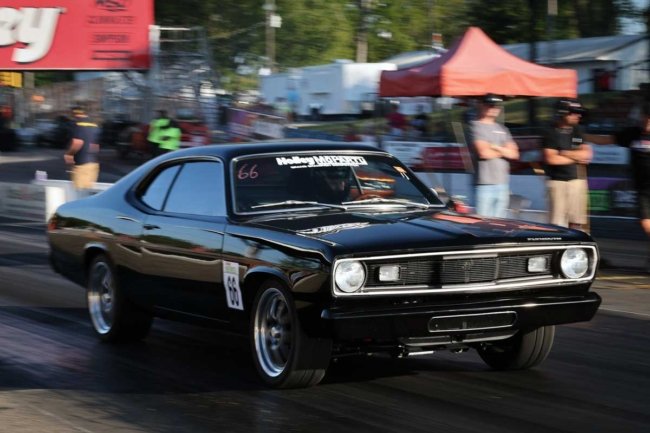
Above: The HDK Suspension did not have the front-end rise necessary for the ultimate acceleration, but the suspension is not designed for drag racing. The suspension in Talbot’s Duster is set up for an autocross event. (Photo – Owner’s Collection)
During the cluster movement, Talbot widened the cluster to fit several gauges by making a mold of the factory bezel and recreating it in fiberglass with a more substantial center section. After piecing it together, he fitted natural walnut wood trim rather than the fake factory wood sticker. The walnut theme continued to the console. It was modified by removing the ashtray and grafting in a bezel to attach a non-console shifter boot.
With all the modifications to the interior, the Duster could not have a stock-appearing steering wheel (Tuff Wheel). So, rather than having the foam grip on the Tuff Wheel, Talbot cut walnut hoops to create the steering wheel rim. Lastly, the front seats are TMI with matching covers for the rear.
Talbot investigated many options for the Pro-Touring suspension but ultimately decided to use the factory torsion bar configuration augmented with Hotchkis parts and leaf springs. Talbot made a caliper bracket to accept Gen 1 Viper Brembo calipers and a 13.75-inch Challenger rotor. The rear brakes are from a Mustang Cobra.
Above Left: The interior has beautiful TMI seats with pleated inserts and plenty of bolster to position Talbot in the seat during heavy cornering. Above Right: Talbot’s Duster is motivated by a 408 stroker fitted with gas-friendly pistons. The engine bay has each panel smoothed to perfection. All the wiring has been tucked, resulting in a clean appearance. (Photo – Owner’s Collection)
The rolling stock consists of Rocket Racing wheels (Rocket Attack) with 18×9-inch (front) and 18×10-inch (rear). The tires selected are Falken Azenis RT660. The Pro-Touring Duster ran in this configuration for about three years. Talbot stated, “It was extremely impressive how good it was with basically a modified stock suspension setup with good shocks and large torsion bars.”
In the summer of 2023, Denny Laube of HDK Suspension contacted Talbot about optimizing the HDK coil-over/rack and pinion front suspension designed for handling performance. Talbot accepted the offer, and after extensive installation work, he performed the final touches on the alignment of the Duster just before leaving for the Holley Moparty.
Talbot revealed, “I didn’t know what to expect, and this would be my first time dealing with double adjustable shocks. I felt like I was getting used to the new setup, and it rained on us. I wasn’t able to push the car that weekend. I finished 4th out of 20 in the Grand Champion Competition vintage class.”
Just weeks later, Talbot competed at a Cruisin’ the Coast event. After making a dozen runs in two hours, Talbot gained some experience setting up and driving the Duster with the new front suspension. He also figured out the corner braking of the new six-piston Wilwood brakes.
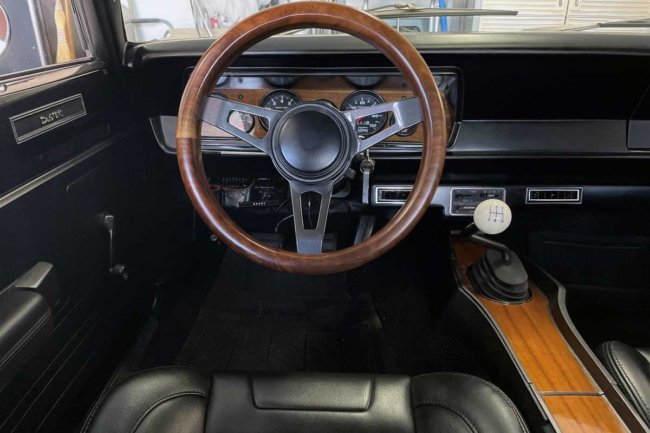
Above: The instrument cluster bezel, center console, radio and heater control area, dash cover, and steering wheel were all modified by Talbot. The wood is all real rather than the simulated wood stickers the factory installed. The Tuff Wheel grips are also made of natural wood. (Photo – Owner’s Collection)
Talbot stated, “I’ve autocrossed a couple more times since then and have really built some trust in the suspension. It’s pretty good right out the box from HDK. However, I’m currently making some very minor changes to dial in the HDK suspension for aggressive handling performance. The most notable change is simply installing a taller upper ball joint to get more camber gain and raise roll center, which are top complaints from people when they compare torsion bar suspensions to coil-over conversions.”
For the future, Talbot plans to add a pair of wider front wheels and perform a Gen3 Hemi swap. But for now, he will continue fine-tuning the Duster while staying under the radar in his understated triple-threat.









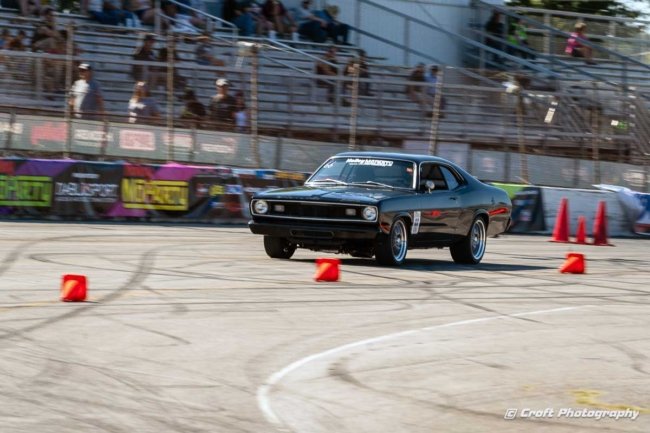
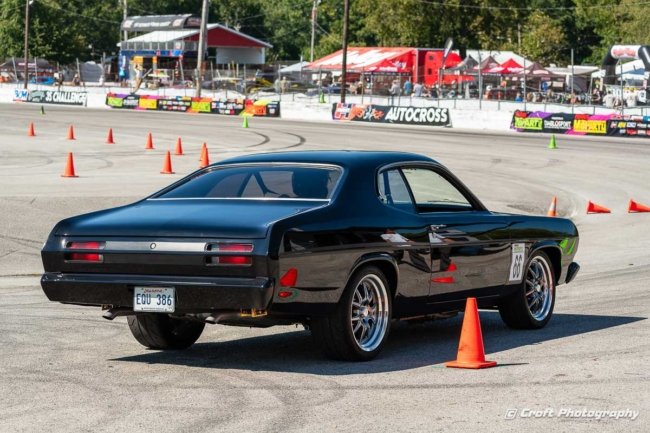
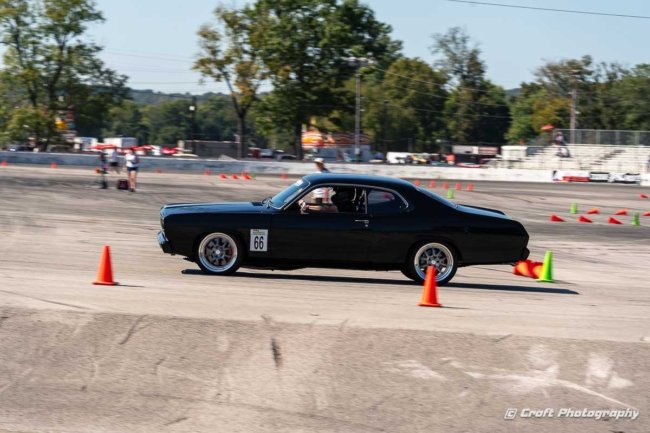


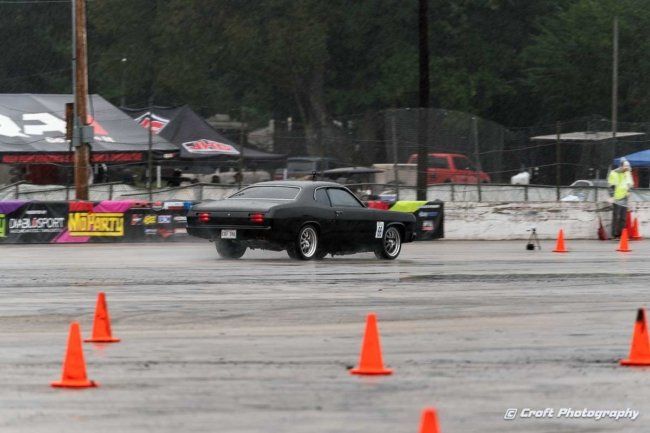


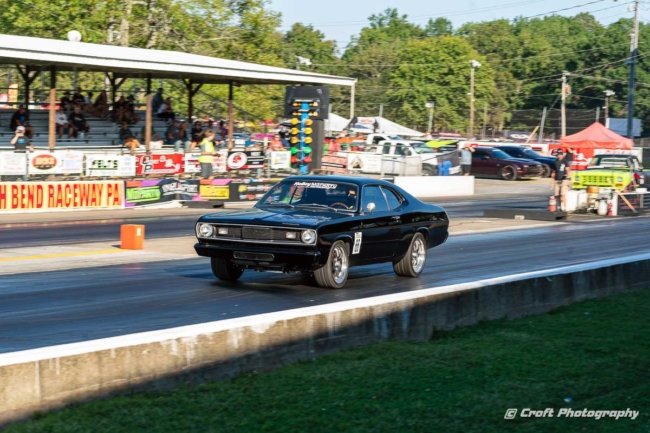




















 Mopar Connection Magazine – The ONLY Daily Mopar Magazine © 2022. All Rights Reserved. Mopar Connection Magazine is the ONLY daily Mopar Magazine bringing you the latest Mopar news, technology, breaking news, and Mopar related events and articles. Find out the latest information about Mopar, Mopar products and services, stay up to date on Mopar enthusiast news, dealership information and the latest Mopar social media buzz! Sign up for the Mopar Connection Magazine newsletter for the latest information about new products, services and industry chatter. Mopar Connection Magazine is the best and only source you need to be a Mopar industry insider!
Mopar Connection Magazine – The ONLY Daily Mopar Magazine © 2022. All Rights Reserved. Mopar Connection Magazine is the ONLY daily Mopar Magazine bringing you the latest Mopar news, technology, breaking news, and Mopar related events and articles. Find out the latest information about Mopar, Mopar products and services, stay up to date on Mopar enthusiast news, dealership information and the latest Mopar social media buzz! Sign up for the Mopar Connection Magazine newsletter for the latest information about new products, services and industry chatter. Mopar Connection Magazine is the best and only source you need to be a Mopar industry insider! by
by